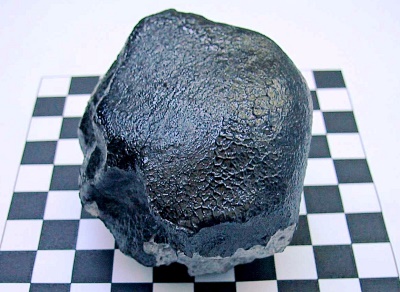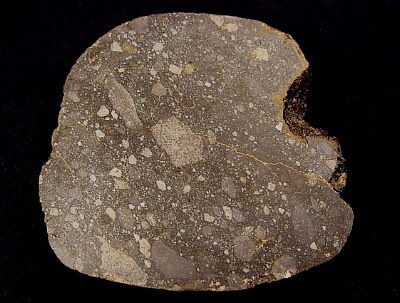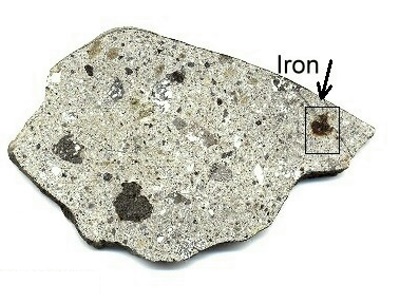IMCA Insights – May 2007
Our Favorite Achondrites, Part 2
by the IMCA Board of Directors
This is the second part of Our Favorite Achondrites, introducing you to some more great samples that have a very special place in the hearts and in the collections of the IMCA Board Members. Enjoy!
Pierre-Marie Pele:
My favorite achondrite is Alby-sur-Cheran [pronounced: Albee Syr Sheran]. I own a small 0.26 grams fragment, and I am one of only three collectors to have a sample of this meteorite. Others are the finder, Mr. Bouchet, and the MNHN in Paris. Alby-sur-Cheran is a small town in the French Alps.
The Main Mass of Alby-sur-Cheran - Photo courtesy Mr. Bouchet
The history of this find is pretty cool. Here's what Mr. Bouchet, the finder, sent to me to illustrate this event:
"The morning of Monday March 18, 2002 (rainy weather), at 8.30am, the storekeepers warned us of a water leakage in the storeroom of the factory (these same people affirm that the leakage was non-existent one hour earlier at the time of their arrivals). One of my colleagues (Mr. Petit) went immediately on the roof and discovered a hole in the bitumen of the roof. It temporarily stopped it with adhesive and covered it with a plate of bitumen then contacted a company to make final repair. On Friday March 22, 2002, I was on the roof of the factory in charge for a visit for safety equipments. Before setting out again, I wanted to look at the hole that Mr. Petit told me about. I removed the plate of bitumen and while searching in the thickness of the insulator, I found a kind of black shining stone, broken at one end, which let me see the gray color of its matter. The aspect of this “stone”, the geographical situation (in height) of the building and the “strength” necessary to create this hole immediately convinced me that it could be a question only of a meteorite; it was approximately 11.45am. The missing 13 grams fragment was found in the afternoon and was used for analysis by the MNHN in Paris."
The date of fall is unknown but according to Mr. Bouchet, it may have occured between the 4th and 12th february 2002. Mr. Bouchet which had always been interested in astronomy found my website and contacted me. I help him to have contacts with the Museum in Paris and a few weeks later, the analysis confirmed it was a monomict eucrite. Total mass is 256.01 grams with a main mass weighing 255.3 grams and about 21 micro-fragments. As a gift, he offered me a sample of this meteorite. I was one of the happiest man in the world as I’m a meteorite collector, especially of French meteorites. As you see on this picture, the Alby-sur-Cheran meteorite is really fresh and crust looks like Camel Donga, even fresher I think.
Adam Hupé:
My personal favorite achondrite is Northwest Africa 3136. NWA 3136 is a unique lunar meteorite from the surface of the lunar Mare basin. It is the only lunar meteorite in private hands to be classified as an ultra-rare Mare Regolith Breccia. Only a few other Mare Basalt type Lunaites have ever been found and they have been classified as various types of basalt, some monomict, some polymict but none a true regolith other than a single meteorite from Antarctica. In my opinion and the scientists who studied it, NWA 3136 may be one of the most important lunar meteorites ever found. What makes it so important is that it is a Mare Regolith that has sampled several types of rocks and layers of the moon over time, kind of like a Howardite is to an asteroid but with more gardening (turning over of rocks). This complete meteorite weighed in at only 95.1 grams and was a perfect oriented shield. This Lunaite is a perfect compliment to the NWA482 main mass which is an oriented highlands specimen which also resides in our collection.
Polished Surface of NWA 3136 Displaying Numerous Rock Type
NWA 3136 is currently being studied by no less than five laboratories with more coming onboard. Two former NASA scientists who studied the Apollo lunar samples are part of the collaborative effort to investigate this meteorite. Old NASA research protocols for the studies of Apollo Lunar Materials have been implemented and a search is under way for possible new minerals. Mare Regoliths are the best candidates to search for new minerals because every Apollo mission where a Mare Regolith was sampled a new mineral was discovered. This polymict regolith breccia meteorite is the most complicated yet found so it may take years to discover what secrets lay within. On top of its scientific value, the matrix is absolutely stunning making for a handsome display specimen. Unfortunately, it is so valuable that the main mass resides in a safe deposit box and is publicly displayed only about once a year.
Andrzej Pilski:
As one can read in the
Cambridge Encyclopedia of Meteorites and in many other books, a
primitive achondrite has an achondritic texture but still retains
something of its chondritic composition. The Zaklodzie meteorite
does have an achondritic texture and does have composition of an
enstatite chondrite. So it is my favorite primitive enstatite
achondrite. However the Nomenclature Committee decided that primitive
enstatite achondrites do not exist, and Zaklodzie is an ungrouped
enstatite-rich meteorite.
When I could see a slice of Zaklodzie first time, I found that it looks
like a slice of Ilafegh 009, which was classified as enstatite chondrite
EL6/7 despite of lacking any chondrule. So I thought Zaklodzie could be
an enstatite chondrite as well. Enstatite achondrites, namely aubrites,
do not contain metal (with rare exception like Mt. Egerton) and
troilite. However my friend petrologist, Dr. Przylibski, found that
texture of Zaklodzie is of cumulate type and resembles some of
terrestrial, plagioclase-bearing pyroxenites. He concluded that
Zaklodzie crystallized from a magma, but the magma did not exist long
enough to allow a differentiation. All in all, however, it is an
achondrite.
A 4.0 g slice of
Zaklodzie, about 25 mm in longest dimension -
Grains of troilite look sligtly brighter than the metal
Most slices of Zaklodzie available for collectors were cut from external part for the stone, which is more weathered. That’s why they are stained rusty. Rare internal fragments contain white enstatite grains. Most of grains are rounded and sometimes they look like chondrules, but their texture is different. Among enstatite grains there are grains of Fe-Ni metal and of troilite. However troilite is much less abundant than metal. There is some plagioclase among enstatite grains. Dr. Patzer found that terrestrial age of Zaklodzie is no longer than 200 years. That means it fell was very recently and should be witnessed in that rather densely populated area of Poland. Indeed a local newspaper reported about a very large bolide with loud detonations following it, on April 20, 1897, (110 years ago). Readers were asked for information about possible meteorites, but no stone was reported to find then. The Zaklodzie stone was found in the area, where the bolide was visible and detonations were heard. Searching for other possible stones has been unsuccessful, thus far.
Ron Hartman:
My favorite achondrite is Dar al Gani 844. Only 4 small slices were made available for purchase, and I obtained three of those in February, 2001 and had one slice split at the UCLA thin section lab to make two thin sections, DaG 844 consists of a single stone, found in 1999 on the Dar al Gani plateau in Libya by Richard and Roland Pelisson. Classified by the open University, UK (Met. Bull. #85) as a polymict-brecciated Eucrite, it is possibly paired with several other similar specimens which were found within what may be a strewn field a few km. across. Some of these are DaG 276, 391, 411, 480 and DaG 669 and 671. The latter two were found near one another and are classified as Howardites (Met. Bull. #85). The finders felt that in small samples, there may be sufficient variation in composition that one part of a main mass can technically classify as an Eucrite and another portion a Howardite, and that this is the case for DaG 844, and thus DaG 844 may be considered to be a Howardite as well.
A 7.4g Slice of Dar al Gani 844, Polymict Eucrite
The finders retained most of the remainder of the main mass, a beautiful black encrusted stone which they had planned to go to the Planetary Studies Foundation collection. I still retain the single slice shown here, and one thin-section. It is not the largest of its kind in my collection, but it was my first Eucrite and in spite of a single badly rusted iron grain, measuring about 3 x 4 mm, the matrix appears remarkably fresh and unstained, exhibiting a characteristic steel gray coloring.
O. Richard Norton photographed the slice shown here for the opening page in his chapter on Differentiated Meteorites, in The Cambridge Encyclopedia of Meteorites (Cambridge University Press, 2002), Norton characterized the slice as being "permeated with dark xenoliths and other crystalline inclusions that seem to bear little relationship to the matrix. The white grains are plagioclase..."
Additional pictures (including a photo of this slice) and a description of this achondrite appear on the SaharaMet Website. (The photo shown here was made by SaharaMet).
In some of our next issues we will present you with some of our favorite iron, and stony-iron meteorites. Stay tuned, and thanks for your interest!
•
IMCA Home Page •
IMCA Code of Ethics •
IMCA Member List
•
Join IMCA •
IMCA Meteorite Info


